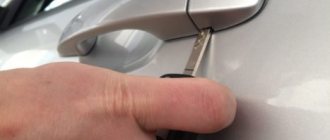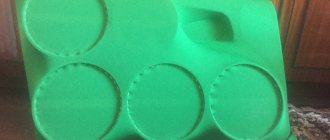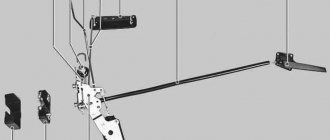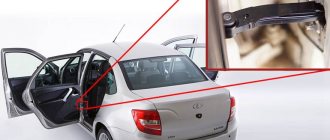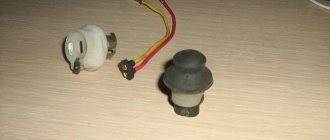Door stops in Lada Vesta are simple but very important mechanisms. They determine the operating comfort of the vehicle - careless movement with incorrectly adjusted limiters, and you risk colliding with another vehicle. In Vesta, the standard locks operate in three positions. We'll tell you what problems may arise with them and what to do to eliminate them.
How to make car door dampers with your own hands
While driving, the door may move up and down, thereby creating squeaks and rubbing. To solve this problem, it is proposed to install special dampers on the mating part of the lock. You can buy this accessory or make it yourself. Let's look at the latter in more detail.
Method No. 1
The method is suitable for Lada Vesta, XRAY, Granta, Kalina, as well as other cars with a similar lock design.
Method No. 2
1.
The owner of Lada XRAY (shafranovich) shared files with damper models for the Lada XRAY car with everyone. If you own a 3D printer, then you can print this model at home. Otherwise, you can apply for 3D printing services in your city.
To download files you need to log in to the site.
The material used for printing was nylon with carbon fiber inside.
After installing the printed dampers, he noted that the sound of the door closing became dull.
2.
The owner of Lada XRAY (kosyagich) also shared a model of dampers for the front and rear doors.
To download files you need to log in to the site.
Source
Hood seal
Next on the list is a powerful three-meter hood seal, which is easily installed with double-sided tape.
It costs about 800 rubles. To seal the engine compartment, one seal is installed from the factory in the front of the hood.
But it is not enough to ensure cleanliness. This seal is mounted around the entire perimeter of the hood. It really effectively prevents dirt from entering the car's engine compartment.
I have always been scrupulous about the cleanliness of the car, not only outside and inside, but also in the engine compartment.
If you are from the same category, then a seal will obviously not be superfluous for you.
Device and principle of operation
The design of a factory-made device is quite complex. The spring mechanism works on compression when opening, and the smooth movement when closing is ensured by a piston system filled with oil. The mechanism housing must be sealed. Making such a device with your own hands is quite difficult.
A homemade door closer, created with your own hands, like a factory-made device, can be based on the elasticity of the material. But at home it is easier to make a lining that acts like a spring, stretching when the door is opened. Returning the closer to its original position attracts the door leaf to the frame, closing it.
The gravitational design is no less simple. The principle of operation of a weighted door closer is that the door returns to its place under the influence of gravity, which puts pressure on the weight, which pulls the door into the closed position.
Metal balls
Everything here is not so simple either. Not all balls are suitable for limiters, but only those with a diameter of 12 mm. Vest owners have already noticed experimentally that these are the balls that are found in bearings 8307 (51307). Buying bearings will not be difficult. As with Focus spare parts, they can be ordered online. The most popular sites with prices are indicated in the list:
- https://podshipnik-rf.ru/index.php?route=product/product&product_id=1914 – 280 rubles;
- https://shop.optorg.ru/catalog/?id=209179 – 291 rubles.
As you can see, the price is not particularly high, but before starting work, the balls must be removed from the bearing.
Bearing 8307 (51307).
However, there is a much simpler way. These are copper-plated metal balls that are sold in hunting stores. They are designed for slingshot shooting. The price of a package of such balls ranges from 150-200 rubles, and there are usually 50 of them in a pack.
You can use these balls.
In this case, it is important that the diameter is exactly 12 mm. If it is 12.2 mm, then the balls will no longer fit, as shown below.
However, you can also use a simple nut by placing it, as shown in the photo.
Options for door closers that you can make yourself
A simple door closer can be easily made with your own hands from a piece of rubber. The elastic material meets all the requirements for the product: it stretches and contracts with a force sufficient to return the door to its zero position. The rubber density must be selected depending on the weight of the door leaf: the heavier it is, the thicker the tape should be used for the door closer.
When installing the device, the ends of the tape are secured as follows:
To adjust the force when opening and closing the door, measure the distance at which the end of the tape is fixed to the door leaf. The farther it is from the hinged side, the more the rubber closer will contract.
Another option for making a closer - gravity - involves the use of a cable with a load. The end of the cord should be attached to the canvas at the top. For reliability, a metal plate with a hole can be used: it is easier to tie a cable to it.
To make a block mechanism, you need a bracket with an axle (for example, from a broken furniture roller or skateboard). If it is possible to use a ready-made block, the task becomes easier, but if it is not available, you can do it in 2 ways:
In the latter case, the cable will slide more easily. It will be possible to attach a weight to the free end of the cord that is sufficient to pull the door leaf to the frame.
Car enthusiasts have the opportunity to make a door closer with their own hands from the lifting mechanism of the luggage compartment of a sedan or hatchback car. This unit is distinguished by the presence of shock absorption and smooth opening functions. The device must first be modified by attaching plates with holes for attaching to the door frame and leaf.
It is easy to make a compact closer from a small holey rubber ball or a medical bulb:
When opened, the corner will compress the ball, squeezing the air out of it. By expanding, the ball will force the door to return to its original position.
A magnetic latch is more appropriate on an interior door. It does not perform a closing function, but reliably holds the door in the closed position in the event of a slight draft. To make the structure, you need a strong magnet and a small steel plate. The parts are attached to the frame and canvas so that when the door is closed they overlap each other. If the thickness of the elements is too large, then you can make recesses in the wooden door for them.
What is the problem?
It lies in insufficient quality of fixation. Vesta limiters have 3 locking modes, but in an intermediate position they cannot reliably hold the door, which is why you have to either open it wide open, which is not always convenient, or constantly hold it with your hand, which quickly gets boring. This problem is especially annoying when the car is parked on a slight slope with the front facing up. In this case, open doors are constantly closed.
There are flaws in the design of the factory limiter of the Lada Vesta.
Spring closer
The most common type of closers are springs. It is not difficult to install a spring closer with your own hands, and the durability of the device is superior to other homemade designs. There are 2 options for installing the closer:
The last option is used if you want to hide a spring that is not decorative.
The spring stiffness must be selected depending on the weight of the door. To prevent the sash from slamming when the spring contracts, it is worth installing a shock absorber. The material for it can be a thin rubber hose: it will not prevent the door from closing smoothly when the door is close to the zero position.
The ends of the spring closer are attached to the frame and canvas with special plates with hooks. When installed on the side of the box, fastening to the frame is done from the hinge side. Depending on the distance from this point to the fastening on the leaf, you can adjust the force of slamming the sash.
St164 › Blog › Dampers for the mating part of locks
The essence of these dampers is additional fixation of the door in the opening in the area of the lock. After all, the door essentially hangs rigidly on only two hinges. In the area of the lock, it only clings to the bracket, but does not lean on it. In addition, the manufacturers have structurally incorporated a technological gap in the pair: lock-mating part of the lock. This technological gap is made for the possibility of assembling the car, since its body is not subject to extremely high precision requirements.
When the vehicle is driven on an uneven road (or when passing obstacles diagonally), the vehicle body will experience torsional loads. Due to the technological gap described above, the doors, as well as the trunk door, begin to move in the doorway.
This effect can be easily noticed when hanging a car diagonally with low torsional rigidity of the body. When opening and closing the doors and trunk, it will be visible that they are warped in the opening.
When driving, the car experiences diverse loads and all the doors begin to move up and down, and in the area where the seals are pressed against the doorway, a friction effect occurs. Considering the ingress of dust and dirt, the effect will be similar to friction with fine sandpaper. The amplitude of door movements is small, but given our uneven roads, the frequency of these movements will be significant.
As a result, problems arise: - creaking of door seals/door velvet against the doorway; — due to the frequent friction of these same seals against the doorway, the paint in the doorway gradually begins to wear off. This is also facilitated by the ingress of sand and dust into the friction zone, and the sealant wipes the paint with this abrasive; — the lock “gnaws through” the mate of the lock. This process also occurs when doors move in a doorway. This can be noticed even on new cars. Just look at your car.
Taking this into account, dampers for the mating parts of locks were developed. They are made in the form of wedge-shaped stops and are designed to eliminate the technological gap in the pair: lock-mating part of the lock.
Features: — the material has a density reminiscent of thick rubber, but at the same time is very wear-resistant; — they are simply placed by manually pulling on the mating part of the lock; — due to elasticity, they can compensate for a slight misalignment of the mating part of the lock with the damper and door lock. But in general, if the door closes poorly, then to avoid poor closing and premature destruction of the installed damper, it is better to adjust the lock mates. To understand what we are talking about here, read about adjusting the mate parts. Described here. — due to the elasticity, the sound of the “slam” of a closing door will be a little quieter; — due to the elasticity of these dampers, the body gradually crushes them. Therefore, the minimum average service life is at least 1 year (again, average, for some it’s enough for a year, while for others they drive until they win until they sell the car). The resource is greatly reduced by unadjusted locks. If the adjustment is made correctly, the dampers are almost eternal. Even if they have been dented over the course of a year, you can turn them over/rearrange them to the other side and use them again.
Regarding personal experience: on the former Octavia A4, the back door is “very long”, the door stop is powerful and almost acts as a closer, so the bang when it closes is loud. With this damper, doors began to close more quietly.
Added a comparison of my damper with the damper from Audi. It's purely a comparison of material. The geometry of the dampers I produce has been modernized.
See installation instructions here
Also, the creaking often comes from the door glass guide seals. There is a special lubricant to eliminate this squeak.
Source
What to do
Refinement of Lada Vesta door limiters is possible in the following ways:
- replacement of standard elements with alternative Ford Focus ones;
- independent modifications by installing a metal ball instead of the inner hemisphere.
The first method is easier to implement, but more expensive. The second is cheaper, but involves large-scale work.
Removing the door trim
The first stage of modification is removing the casing. You need to pry up the edges of the material in the area of the doors, where they easily come off, then carefully remove the upholstery. If you plan to use the removed materials in the future, you should proceed with the utmost caution.

